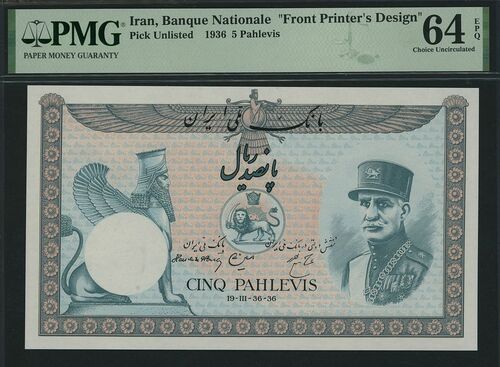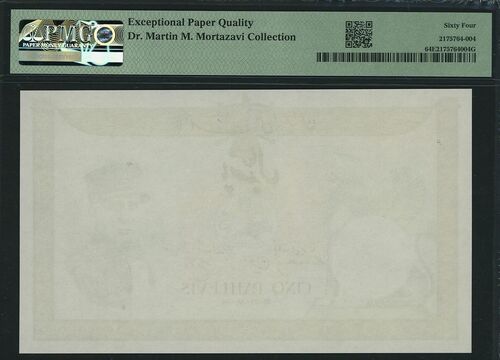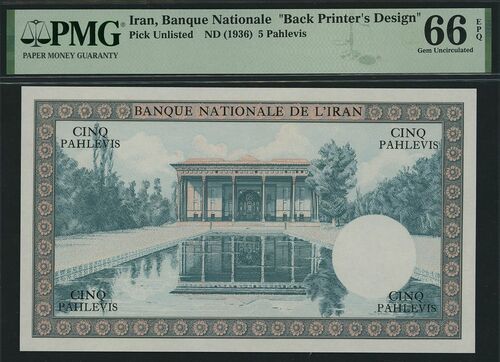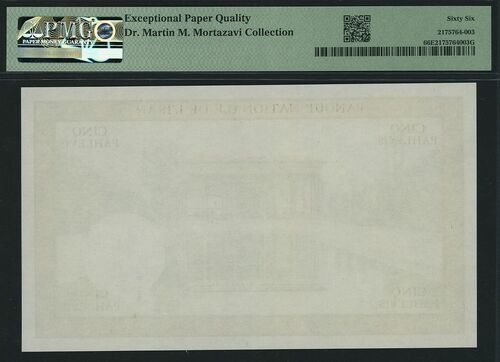Auction: 24038 - The Dr. Martin M Mortazavi Collection of Persian Banknotes
Lot: 61
(x) Banque Nationale de L´Iran, uniface set of front and back Printer's Design 5 Pahlevis, 1936 / ND (1936),
this exquisite banknote set, consisting of a front Printer's Design and a back Printer's Design, exemplifies the height of Persian artistry and historical significance, this design was intended to be used for circulation but was never approved by the issuer, making these notes exceptionally rare and valuable. Thought to have been created by Bank Melli, Iran, these designs offer a captivating glimpse into the rich cultural heritage and intricate craftsmanship of Iran during this period.
The front design, a mesmerising interplay of verdant hues upon a canvas of peach, adorned with delicate wisps of pale green underprint, unveils a spectacle of regal grandeur. To the right, the portrait of Reza Shah commands reverence, his presence a testament to noble authority. At the heart of this symphony of elegance, the national arms stand proud and unyielding, symbolising the enduring strength of a storied nation. To the left, the majestic Lamassu, a mythical creature with the head of a human and the body of a winged bull, stands sentinel, its gaze piercing through the annals of time. Hovering above, the enigmatic figure of Faravahar bestows an ethereal aura upon the scene, its silent vigil a reminder of timeless tradition and heritage. Near the lower margin at centre, the CINQ PAHLEVIS denomination subtly graces the composition, a testament to the intrinsic value of this meticulously crafted design. The front is signed by Abdolhossein Hajier and Hossein Ala'a, with a notable printed date "19-III-36-36," which, along with other historical references, has led PMG to date this note to 1936.
The back of the printer´s design unveils the denomination "CINQ PAHLEVIS" prominently displayed in all corners of the back, printed in a harmonious tableau of verdant green and delicate peach, framing the pièce de résistance, the illustrious Palace of the 40 Columns. This iconic structure, known as Chehel Sotoun, stands as a paragon of Persian architectural excellence in the heart of Isfahan. Built during the Safavid era, the palace served as a grand reception hall and an emblem of royal magnificence.
The architectural marvel features twenty slender wooden columns supporting the grand entrance pavilion. Yet, it is the reflection in the tranquil pool before the palace that lends it the name "40 Columns," as the shimmering water doubles their number in a stunning optical illusion. The pool itself stretches serenely before the palace, creating a mirror-like surface that captures the grandeur of the columns and the intricate carvings adorning the structure.
Within the palace, the walls are adorned with vivid frescoes and intricate tile work depicting historical scenes, battles, and royal ceremonies, each a testament to the artistry and craftsmanship of the era. The grandeur of the palace, with its towering columns and serene reflections, invites contemplation and admiration, encapsulating the rich tapestry of Persian heritage and the enduring legacy of its architects and craftsmen. Both the portrait of Reza Shah and the representation of the Palace of the 40 Columns on this banknote are reminiscent of those used on the issued 50 Rials banknote from the 1933-1935 issues, further intertwining the historical and artistic narrative of this exquisite piece.
Perhaps the most significant detail of this note is the name of the bank, inscribed as "Bank Nationale de L'Iran" on the back. This unique designation was never used on any other note issued by Iran, making this banknote exceptionally rare,
(Pick Unlisted), in PMG holder 64 EPQ Choice Uncirculated 1), 66 EPQ Gem Uncirculated (1), (total 2 notes)
Subject to 5% tax on Hammer Price in addition to 20% VAT on Buyer’s Premium.
Sold for
£3,800
Starting price
£1700











